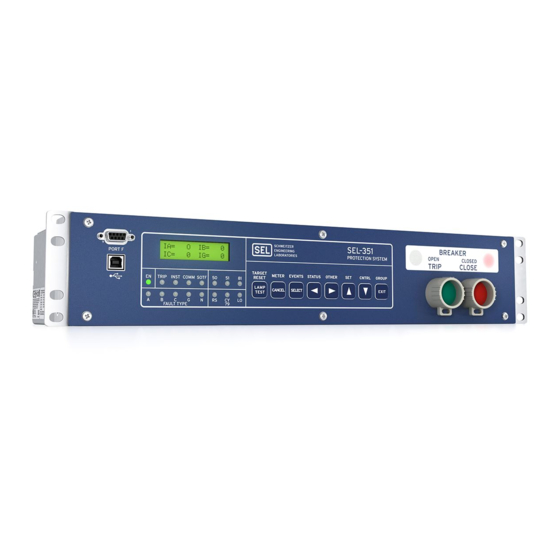
Schweitzer Engineering Laboratories SEL-351 Manuals
Manuals and User Guides for Schweitzer Engineering Laboratories SEL-351. We have 1 Schweitzer Engineering Laboratories SEL-351 manual available for free PDF download: Instruction Manual
Schweitzer Engineering Laboratories SEL-351 Instruction Manual (614 pages)
DIRECTIONAL OVERCURRENT RELAY RECLOSING RELAY FAULT LOCATOR
Brand: Schweitzer Engineering Laboratories
|
Category: Relays
|
Size: 6 MB
Table of Contents
-
-
-
Applications23
-
-
-
-
-
-
Model 0351Xt50
-
Power Supply50
-
Model 0351X051
-
Serial Ports54
-
Example57
-
-
-
-
-
Accuracy96
-
-
Accuracy103
-
Settings Ranges103
-
-
-
Settings Ranges104
-
Accuracy105
-
-
-
Accuracy106
-
Settings Ranges106
-
-
-
Voltage Elements107
-
-
Setting SYNCP118
-
Accuracy118
-
-
-
Voltage Window122
-
S Are "Slipping124
-
-
-
-
-
Setting ELOP = y148
-
Setting ELOP = N148
-
-
Internal Enables155
-
Internal Enables164
-
-
-
Settings173
-
-
-
Trip Logic187
-
Set Trip189
-
Unlatch Trip190
-
-
Set Trip191
-
Unlatch Trip192
-
-
-
-
Trip Setting DTT199
-
-
External Inputs200
-
Timer Settings201
-
Logic Outputs202
-
-
External Inputs206
-
Timer Settings207
-
Logic Outputs207
-
-
External Inputs210
-
Timer Settings211
-
Logic Outputs211
-
-
-
COMM Target LED216
-
INST Target LED216
-
TRIP Target LED216
-
50 Target LED217
-
G Target LED217
-
SOTF Target LED217
-
79 Target Leds218
-
N Target LED218
-
-
-
Close Logic223
-
Set Close224
-
Unlatch Close225
-
-
Set Close226
-
Unlatch Close226
-
-
-
Reclosing Relay234
-
-
Lockout State236
-
-
-
-
-
-
-
Ogic280
-
-
Power Loss287
-
Settings Change287
-
-
Sel Ogic288
-
Output Contacts292
-
-
-
Breaker Monitor307
-
-
Via Serial Port318
-
Via Front Panel319
-
-
Introduction307
-
-
-
Via Front Panel324
-
Via Serial Port324
-
-
Demand Metering326
-
-
Via Front Panel334
-
Via Serial Port334
-
-
Energy Metering334
-
-
-
Introduction343
-
Settings Sheets379
-
-
-
Introduction407
-
-
Irig-B408
-
SEL-351 to Modem410
-
-
-
Access Level 0415
-
Access Level 1416
-
Access Level B416
-
Access Level 2417
-
-
Command Summary417
-
-
-
-
-
Overview451
-
-
Introduction451
-
-
-
-
Introduction467
-
-
Event Type470
-
Currents471
-
Fault Location471
-
Targets471
-
-
-
-
Introduction507
-
Relay Self-Tests512
-
-
-
-
Introduction537
-
Message Lists537
-
-
DNA Message548
-
BNA Message549
-
-
-
-
-
Relay Word Bits571
-
-
-
Overview585
-
Device Profile587
-
Object Table590
-
Data Map593
-
Point Remapping597
-
Other Versions598
-
-
To 4
603-
Overview603
-
Operation603
-
Mirrored Bits609
-
Settings612
-
Advertisement
Advertisement
Related Products
- Schweitzer Engineering Laboratories SEL-351S
- Schweitzer Engineering Laboratories SEL-351-1
- Schweitzer Engineering Laboratories SEL-351-0
- Schweitzer Engineering Laboratories SEL-351-3
- Schweitzer Engineering Laboratories SEL-351-2
- Schweitzer Engineering Laboratories SEL-351-4
- Schweitzer Engineering Laboratories SEL-351-5
- Schweitzer Engineering Laboratories SEL-351-6
- Schweitzer Engineering Laboratories SEL-351-7
- Schweitzer Engineering Laboratories SEL-351R
